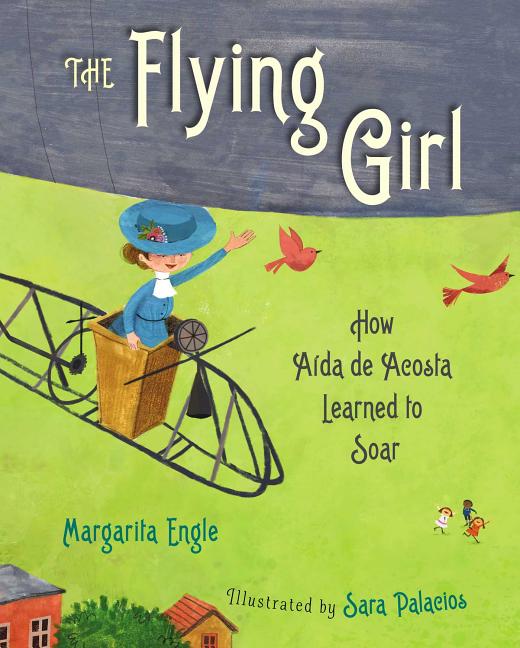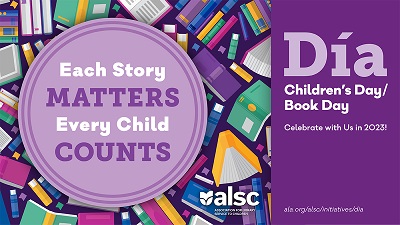
Book Resume
for The Flying Girl: How Aída de Acosta Learned to Soar by Margarita Engle and Sara Palacios
Professional book information and credentials for The Flying Girl.
6 Professional Reviews (1 Starred)
2 Book Awards
Selected for 1 State/Province List
See full Book Resume
on TeachingBooks
- Publisher's Weekly:
- Ages 4 - 8
- Kirkus:
- Ages 4 - 8
- School Library Journal:
- Grades 2 - 5
- Booklist:
- K - Grade 3
- TeachingBooks:*
- Grades PK-2
- Word Count:
- 752
- Lexile Level:
- 1150L
- ATOS Reading Level:
- 4.5
- Cultural Experience:
- Latino (US / Canada)
- Women / Girls
- Genre:
- Biography
- Nonfiction
- Picture Book
- Year Published:
- 2018
18 Subject Headings
The following 18 subject headings were determined by the U.S. Library of Congress and the Book Industry Study Group (BISAC) to reveal themes from the content of this book (The Flying Girl).
- Children's Books/Ages 4-8 Nonfiction
- Juvenile Nonfiction | Biography & Autobiography | Women
- Women in aeronautics
- Santos-Dumont, Alberto
- Women
- Women air pilots
- Juvenile Nonfiction | People & Places | United States - Hispanic/Latino
- Juvenile Nonfiction | Transportation | Aviation
- Santos-Dumont, Alberto, 1873-1932--Juvenile literature
- Women air pilots--United States--Biography--Juvenile literature
- Acosta, Aida de, 1884-1962--Juvenile literature
- Airships
- Women in aeronautics--History--Juvenile literature
- Biographies
- History
- Airships--Juvenile literature
- United States
- Acosta, Aida de
6 Full Professional Reviews (1 Starred)
The following unabridged reviews are made available under license from their respective rights holders and publishers. Reviews may be used for educational purposes consistent with the fair use doctrine in your jurisdiction, and may not be reproduced or repurposed without permission from the rights holders.
Note: This section may include reviews for related titles (e.g., same author, series, or related edition).
From Horn Book
July 1, 2018
In this slightly fictionalized account (with brief invented dialogue), Engle and Palacios introduce readers to Latina air-and-space pioneer Amda de Acosta (18841962), who defied the sexist attitudes of her era to learn to pilot dirigibles. Lilting, intermittently rhyming text highlights the difficulties Amda faced. Mixed-media illustrations capture the giant scale of the dirigibles without sacrificing detail in scenes of people on the ground.
(Copyright 2018 by The Horn Book, Incorporated, Boston. All rights reserved.)
From Horn Book
May 1, 2018
In this slightly fictionalized account (with brief invented dialogue) Engle and Palacios introduce readers to A�da de Acosta (1884-1962), who defied the sexist attitudes of her era to learn to pilot dirigibles. Lilting, intermittently rhyming text shows teenage A�da's curiosity, as she convinces the airship's inventor to teach her to fly despite her mother's protests. The book highlights the difficulties A�da faced, from smaller problems such as when her long dress made it hard to exit the airship to larger ones like the jeers from angry strangers after her groundbreaking flight. Mixed-media illustrations range from serviceable to whimsical and capture the giant scale of the dirigibles without sacrificing detail in scenes of people on the ground. A motif of red birds throughout reflects A�da's buoyant spirit. A biographical note, including the information that A�da kept silent about her story for years afterward in deference to her father, is appended. This story based on the life of a Latina air-and-space pioneer is a welcome addition to the growing list of picture-book biographies of women who defied expectations. christina l. dobbs
(Copyright 2018 by The Horn Book, Incorporated, Boston. All rights reserved.)
From Publisher's Weekly
February 19, 2018
Writing in upbeat, intermittently rhyming verse, Engle tells the true story of Aída de Acosta, an American woman of Cuban and Spanish descent who piloted an early flying machine. While visiting Paris as a teenager, Acosta is awestruck by eccentric inventor Alberto Santos-Dumont’s motorized aircrafts and is determined to pilot one. Despite objections—“Girls, they hollered, should only be allowed/ to learn how to cook, sew, and clean,/ but girls, they bellowed, should never/ be taught how to fly/ huge machines”—Acosta successfully flies a dirigible, landing in a polo field near Paris. Palacios’s mixed-media artwork features ruby and sapphire jewel tones, including in flocks of red birds that accompany Acosta’s journey. Engle delivers a sweetly uplifting story about a girl who “only needed courage and a chance to try.” Ages 4–8. Agent: Michelle Humphrey, Martha Kaplan Agency.
From Kirkus
Starred review from December 15, 2017
National Young People's Poet Laureate Engle brings to children the story of Aida de Acosta, who in 1903 became the first woman to fly a motorized aircraft.In her trademark free-verse style, Engle tells the story of Aida, a white Hispanic teenager from New Jersey who, on a trip to Paris, is dazzled by the sight of a balloon gliding by with an air boat dangling beneath and a man inside it. Determined to fly too, Aida approaches the inventor of the airship: Alberto Santos-Dumont, a Brazilian inventor known in his country as the father of aviation, achieving flight six months before the Wright brothers. Aida learns to fly, and fly she does, much to the consternation of her contemporaries: "girls, they bellowed, should never / be taught how to fly / huge machines." Palacios' exuberant mixed-media artwork is vibrant and colorful, in tune with Aida. Readers will chuckle at her portrayal of an aerial dinner with the waiters on stilts. In a closing note the author gives additional detail, including Aida's promise to her father that she would keep her daring deed a secret and, later in life, after losing an eye to glaucoma, her becoming the director of the first eye bank in America.A beautiful account of a young woman who knew that all she needed to reach her dream was courage and a chance to try. (Picture book. 4-8)
COPYRIGHT(2017) Kirkus Reviews, ALL RIGHTS RESERVED.
From School Library Journal
December 1, 2017
Gr 2-5-Aida de Acosta's fascination with flying and her determination to do so allowed her to accomplish this very task as a young teenager. She studied under Alberto Santos-Dumont and after various lessons, flew an airship during a sunny day in Paris. Unfortunately, when she landed, she was met by an unruly crowd who shouted insults at her (even her mother was opposed). What were they to think of a woman flying; after all, the year was 1903! In the text, however, Santos-Dumont greets her with kind words: "You're a hero, such a brave inspiration for all the girls of the world!" The mixed-media illustrations flow perfectly with the story and provide a calming tone. This introductory biography will guide readers on their way to finding out more about de Acosta and women in aeronautics in general. The author's note provides valuable information about both de Acosta and Santos-Dumont. VERDICT A great resource for STEM classrooms and readers interested in historical figures who paved the way for modern day pioneers.-Martha Rico, El Paso ISD, TX
Copyright 2017 School Library Journal, LLC Used with permission.
From Booklist
December 1, 2017
Grades K-3 Aida de Acosta has the distinction of being the first woman to fly a motored aircraftin 1903, about six months before the Wright brothers' famous first flight. De Acosta, a Hispanic American teenager, was visiting Paris when she observed a flying machine and became determined to learn to fly it herself. Alberto Santos-Dumont, Brazil's Father of Aviation and the airship inventor, understood her desire and gave her three lessons before she made her one and only solo flight. Playful language with intermittent rhymes and repetition results in an enjoyable easy-to-read biography for young children of a little-known historical figure. The digitally enhanced mixed-media illustrations in blues, browns, greens, and rust reveal a variety of perspectives and were created using colored pencil, gouache, and markers. De Acosta's determination in making her dream come true serves as an inspiration to young girls: they can soar in whatever endeavor they choose to pursue: If that man can fly, so can I. All I need are some lessons and a chance to try! (Reprinted with permission of Booklist, copyright 2017, American Library Association.)
2 Book Awards & Distinctions
The Flying Girl was recognized by committees of professional librarians and educators for the following book awards and distinctions.
1 Selection for State & Provincial Recommended Reading Lists
The Flying Girl was selected by educational and library professionals to be included on the following state/provincial reading lists.
United States Lists (1)
California
Preview Digital Book
Explore The Flying Girl on Marketplace. Access requires OverDrive Marketplace login.
This Book Resume for The Flying Girl is compiled from TeachingBooks, a library of professional resources about children's and young adult books. This page may be shared for educational purposes and must include copyright information. Reviews are made available under license from their respective rights holders and publishers.
*Grade levels are determined by certified librarians utilizing editorial reviews and additional materials. Relevant age ranges vary depending on the learner, the setting, and the intended purpose of a book.
Retrieved from TeachingBooks on February 01, 2025. © 2001-2025 TeachingBooks.net, LLC. All rights reserved by rights holders.







 El día de los niños / El día de los libros, 2013-2024, Selection, 2019
El día de los niños / El día de los libros, 2013-2024, Selection, 2019
 International Latino Book Awards, 2000-2024, First Place Winner, 2018
International Latino Book Awards, 2000-2024, First Place Winner, 2018
